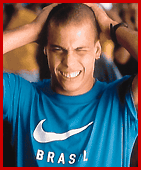Because it was difficult to get players and equipment in the same place at the same time (the whole crew once waited seven hours for Ronaldo to show up), much of the shoot was done at midday. The bright overhead sun not only made the asphalt brutally hot to shoot on, but created tough lighting issues as well. "The windows on the departure lounge were covered with a massively thick neutral-density coating," recalls Tattersall. "Whatever lights we thought were powerful enough ended up being three stops less than we’d figured."
No matter how brief a scene may be, Tattersall adds, it’s critical to keep the lighting coming from the same direction at the same level. "It’s important to be honest to the lighting integrity," he maintains. "That helps to achieve a believable finished product, especially if shots are going to be composited together. If something’s wrong, the human brain will pick it up, even if the viewer may not be able to put a finger on it."
Airport security policies prevented the crew from placing lights in many areas, and the safety of the soccer players also became a factor. Tattersall recalls, "Because it was very dangerous to have players on the runways, a lot of the outdoor shots were done in front of a 20’ by 20’ greenscreen, which was the largest we could find. The airplane was matted in later."
Digital techniques were also used to pull off a gag involving a moving baggage cart. The cameraman explains, "We did a shot of a player kicking the ball, took the real ball away and substituted a CG ball. We then used the computer to change its path and make it appear as if the player had kicked it through the open door of a moving cart on a live runway."
Because the spot required a substantial amount of postproduction image processing, the cinematographer tried to use as little lens filtration as possible. "I tried to keep it fairly clean," notes Tattersall. "It’s important not to get too heavy with special filters if you expect to get tricky in post. It’s best to give the post people the cleanest possible images."
The spot was shot almost entirely using Kodak’s EXR 5293 film stock, which he rated at 125 ASA using standard 85 correction. "We went with a stock that was fast enough to shoot interiors, yet fine-grained enough to work in post," notes Tattersall, who shot with his traditional Arriflex camera package, including the 435ES. "These relatively new cameras have high-speed capability and can run up to 150 frames per second. The 435ES also gives you the wonderful option of being able to change the speed of the shot during normal shooting and have the electronic shutter compensate for the difference. The aperture stays the same, but the shutter slowly closes." Some of the kicking shots were run at normal speed until the moment the ball was kicked. The camera was then cranked up to a high speed. "This makes the ball appear to float a bit, and gives it a bit more of a magical feel," Tattersall observes. "Otherwise, the ball would quickly disappear from sight in three frames."
Since the crew didn’t know what they would run into while shooting, a complete package of Zeiss lenses was ordered. "We relied heavily upon the faster lenses. People kept turning up late, and we would have to re-create the departure lounge lighting to make it look like the middle of the day," the cameraman recounts.
After wrapping the Nike shoot, Tattersall flew immediately to Canada to shoot Mike Newell’s black comedy Pushing Tin. Reflecting upon on his time in Brazil, he says that he enjoyed the experience despite the difficult working conditions. "Believe it or not, shooting commercials is like a break for me. Looking back, there was nothing we could have done better when we were in the trenches."
